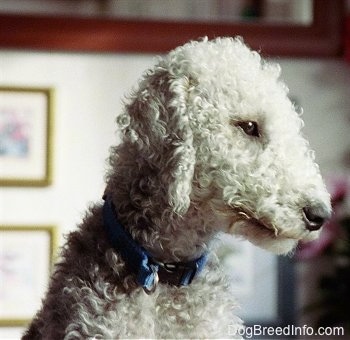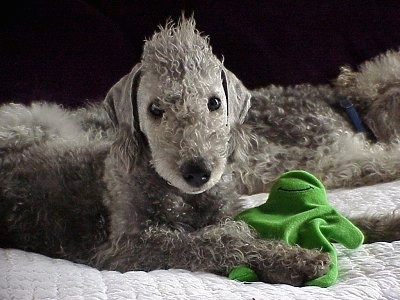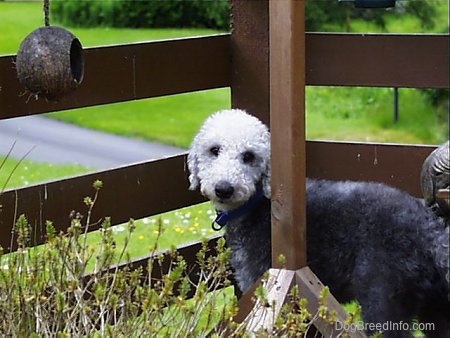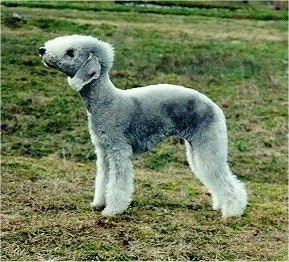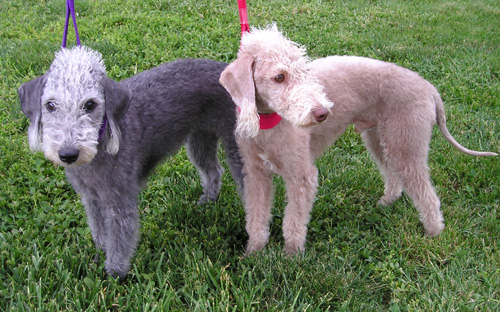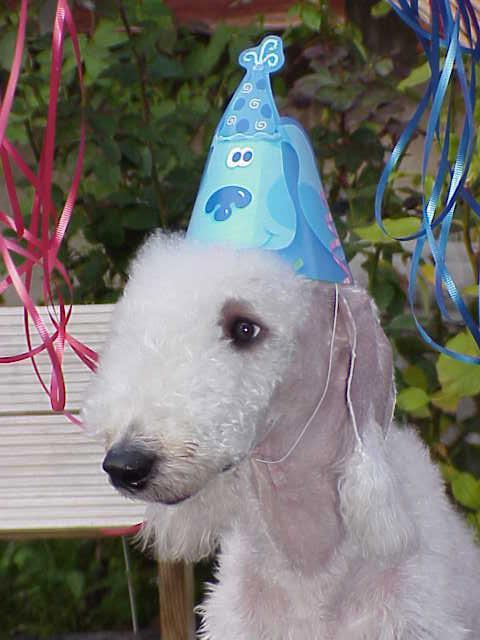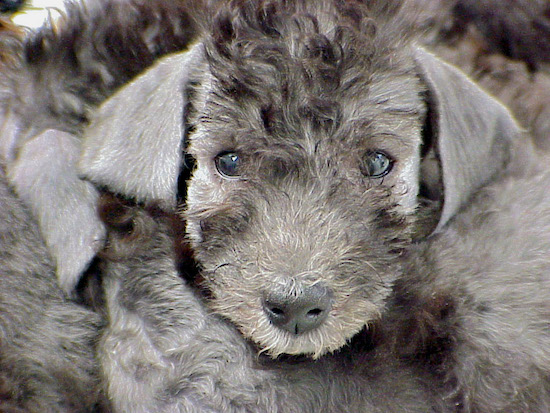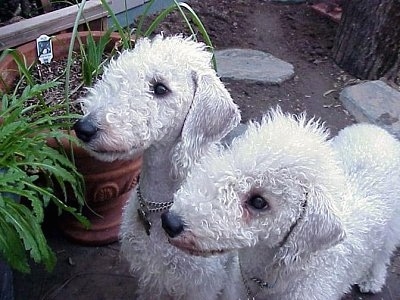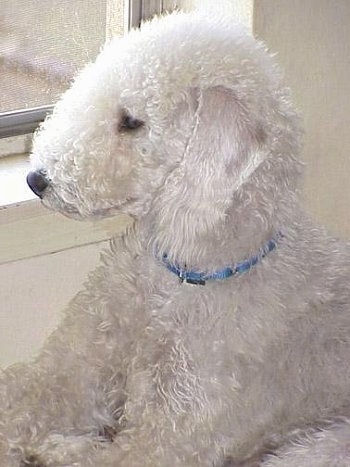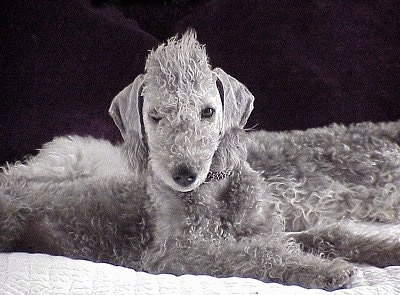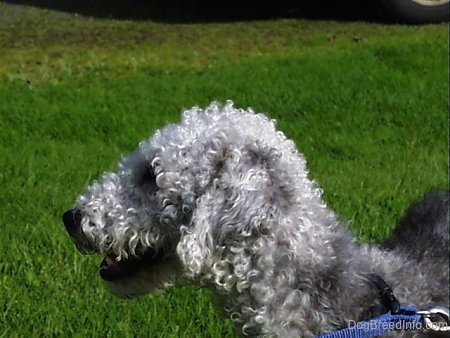The Bedlington Terrier is a breed of terrier named after the mining town of Bedlington, Northumberland in North East England.
Appearance
Appearance
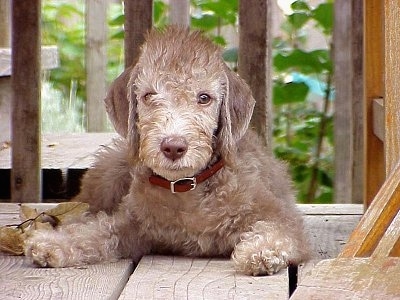 The Bedlington Terrier is often described as looking like a lamb on a leash, probably because it has non-shedding fur with a woolly texture. These dogs may be blue, sandy, liver, or dark brown/black and sable and can be solid colours or have tan markings. These become paler as the dog grows older, but should never be pure white, which indicates a lack of "guard hairs;" the harsh hairs in their coat that give it texture and offer the dogs protection.
The Bedlington Terrier is often described as looking like a lamb on a leash, probably because it has non-shedding fur with a woolly texture. These dogs may be blue, sandy, liver, or dark brown/black and sable and can be solid colours or have tan markings. These become paler as the dog grows older, but should never be pure white, which indicates a lack of "guard hairs;" the harsh hairs in their coat that give it texture and offer the dogs protection.This breed has a wedge-shaped head with sparkling, triangular eyes. Although it looks meek when in repose, the Bedlington Terrier is every inch a terrier when aroused. Its body shape, however, is unusual for a terrier, being somewhat like a Greyhound or Whippet in construction, which enables it to gallop at great speed. However,
the front legs are constructed differently from those quick hounds (and almost all other breeds of dogs) in that the front legs are closer together at the feet than at the elbows - creating a triangular shape when viewed from the front. This enables a Bedlington Terrier to turn or pivot quickly when chasing quarry at high speed. The Bedlington moves with unique, light movement and seems to "float" above the ground. It should never have a hackney gait (the high-stepping action of some ponies, miniature pinschers or Italian greyhounds). They should cover ground effortlessly, but with power and grace.
Bedlington Terriers are groomed with long hair left on the top of their skull and muzzle, tassels on the ears and slightly longer furnishings on the legs than the body coat. This practice is thought to have originated when the Bedlington was used to hunt vermin. The quarry, trying to escape, would bite at the dog, and the hair saved the Bedlington from an injury to the important facial area and possible death from an infection. A similar idea is seen in the tail, crest and wings of the Secretary Bird
Temperament
Bedlington Terriers are groomed with long hair left on the top of their skull and muzzle, tassels on the ears and slightly longer furnishings on the legs than the body coat. This practice is thought to have originated when the Bedlington was used to hunt vermin. The quarry, trying to escape, would bite at the dog, and the hair saved the Bedlington from an injury to the important facial area and possible death from an infection. A similar idea is seen in the tail, crest and wings of the Secretary Bird
Temperament
Calmer and less boisterous than many other terriers, the Bedlington Terrier is known as a dog with a good nature and mild manners. In addition, it is fast enough to bay a badger or a fox and is a first-rate water dog. Incredibly smart and attentive to its owner, the Bedlington is one of the most reliable terriers. They are problem solvers and loyal family companions.
Grooming
Weekly combing and professional grooming are needed every 6-8 weeks to keep their coats
Grooming
Weekly combing and professional grooming are needed every 6-8 weeks to keep their coats
(which tend to curl) in good shape. Dogs being prepared for the show ring often have much more hair left on them than those in "pet clips," which provide pet owners with a more manageable trim for their pets. The show trim is entirely hand-scissored, with the exception of the ears, face/throat, belly and tail which are trimmed with an electric clipper. It can take years to master the grooming pattern for this breed.
Exercise
These high-energy dogs need several vigorous walks and aerobic play sessions daily to keep them happy and content. The breed is well suited for agility, earthdog, obedience and other performance events.
Hypoallergenic qualities
Exercise
These high-energy dogs need several vigorous walks and aerobic play sessions daily to keep them happy and content. The breed is well suited for agility, earthdog, obedience and other performance events.
Hypoallergenic qualities
Bedlington Terriers often appear on lists of dogs that do not shed (moult), but this is misleading. Every hair in the dog coat grows from a hair follicle, which has a cycle of growing, then dying and being replaced by another follicle. When the follicle dies, the hair is shed. The length of time of the growing and shedding cycle varies by breed, age, and by whether the dog is an inside or outside dog. "There is no such thing as a nonshedding breed." The grooming of the Bedlington helps remove loose hair, and the curl in the coat helps prevent dead hair and dander from escaping into the environment, as with the poodle's coat. The frequent brushing and bathing required to keep the Bedlington looking its best removes hair and dander and controls the other potent allergen, saliva. Although hair, dander, and saliva can be minimized, they are still present and can stick to "clothes and the carpets and furnishings in your home"; inhaling them, or being licked by the dog, can trigger a reaction in a sensitive person.
History
History
The famed progenitor of Bedlington was a dog named "Old Flint", whelped in 1782 and owned by "Squire Trevelyan." Originally, the breed was known as the "Rothbury" or "Rodbery Terrier." This name derived from a famous bitch brought from Staffordshire by a company of nail makers who settled in Rothbury. The Terriers of this section were accustomed to rodent hunting underground, and worked with packs of foxhounds kept there at the time.
It is suggested that the Bedlington may well have made its way to Ireland and played a part in the early development of the Kerry Blue Terrier.
The first Bedlington Terrier club was formed in 1877. The Bedlington Terrier was recognized by the United Kennel Club in 1948.
Ch. Femars' Cable Car, winner of best-in-show at the Westminster Kennel Club Dog Show in 1948, was featured on the cover of Sports Illustrated in the February 1960 edition.
Health
It is suggested that the Bedlington may well have made its way to Ireland and played a part in the early development of the Kerry Blue Terrier.
The first Bedlington Terrier club was formed in 1877. The Bedlington Terrier was recognized by the United Kennel Club in 1948.
Ch. Femars' Cable Car, winner of best-in-show at the Westminster Kennel Club Dog Show in 1948, was featured on the cover of Sports Illustrated in the February 1960 edition.
Health
Mortality
Median longevity of Bedlington Terriers, based on two recent UK surveys, is about 13.5 years, which is longer than for purebred dogs in general and longer than most breeds similar in size. The longest-lived of 48 deceased dogs in a 2004 UK Kennel Club survey was 18.4 years. Leading causes of death among Bedlington Terriers in the UK were old age (23%), urologic (15%), and hepatic (12.5%). The leading "hepatic" cause of death was copper toxicosis. Dogs that died of liver diseases usually died at a younger age than dogs dying of most other causes.
Morbidity
Bedlington Terrier owners in the UK reported that the most common health issues among living dogs were reproductive (primarily of concern to breeders), heart murmur, and eye problems such as epiphora and cataracts. Copper toxicosis occurred among about 5% of living dogs.
Morbidity
Bedlington Terrier owners in the UK reported that the most common health issues among living dogs were reproductive (primarily of concern to breeders), heart murmur, and eye problems such as epiphora and cataracts. Copper toxicosis occurred among about 5% of living dogs.
Copper Toxicosis; Copper Storage Disease
Bedlington Terriers have an unusually high incidence of copper toxicosis, an inherited autosomal recessive disease, characterized by accumulation of excess copper in the liver. Genetic testing is now available. The disease is diagnosed with a liver biopsy. It is essential that anyone interested in purchasing a Bedlington is provided with proof of the dogs' unaffected status.
Description
The Bedlington Terrier has the appearance of a little lamb. The dog's pear-shaped head is narrow, but deep and rounded. The muzzle is strong with no stop. The almond-shaped eyes are small and deep-set. The jaw meets in a level or scissors bite. The low set ears are triangular with rounded tips. The chest is deep and the back is arched. The back legs are longer than the straight, front legs. The tail is low set, thick at the root and tapering to a point. Dewclaws are usually removed. The Bedlington has a thick double coat of a mixture of hard and soft hair standing out from the skin. Colors come in blue, sandy, liver, blue and tan, sandy and tan, and liver and tan. Tan markings may appear over the eyes, on the chest, legs and rear.
Temperament
Description
The Bedlington Terrier has the appearance of a little lamb. The dog's pear-shaped head is narrow, but deep and rounded. The muzzle is strong with no stop. The almond-shaped eyes are small and deep-set. The jaw meets in a level or scissors bite. The low set ears are triangular with rounded tips. The chest is deep and the back is arched. The back legs are longer than the straight, front legs. The tail is low set, thick at the root and tapering to a point. Dewclaws are usually removed. The Bedlington has a thick double coat of a mixture of hard and soft hair standing out from the skin. Colors come in blue, sandy, liver, blue and tan, sandy and tan, and liver and tan. Tan markings may appear over the eyes, on the chest, legs and rear.
Temperament
The Bedlington Terrier is playful, cheerful and affectionate, making a good family companion. Loving with children and fairly friendly with strangers. Loyal and lively, but can become willful and stubborn if they sence their owners are meek or passive. This breed needs to learn to get along with cats and other household animals when they are young. Usually they can get along with other dogs, but keep them away from those that want to dominate, as once challenged they are terrifying fighters, despite their gentle appearance. Often called a "little powerhouse,", it is brave and energetic An enthusiastic digger. They are super fast runners and need to be taught to come back when called. Bedlington like to bark, and need to be told enough is enough, if it becomes too obsessive. They can be high-strung without enough mental and physical exercise. Only let this breed off its lead in an enclosed area. Like the Whippet, he is fast and loves to chase! Be sure you are always your dogs firm, confident, consistent pack leader, to avoid Small Dog Syndrome, and separation anxiety.
Height, Weight
Height: Dogs 16-17 inches (41-43cm) Bitches 15-16 inches (38-41cm)
Weight: Dogs 18-23 pounds (8-10kg) Bitches 18-23 pounds (8-10kg)
Health Problems
Bedlington Terriers may have a serious inherited liver problem known as Copper Storage Disease. They are also prone to hereditary kidney disease, PRA, thyroid problems and eye problems, such as cataracts and retinal disease.
Height: Dogs 16-17 inches (41-43cm) Bitches 15-16 inches (38-41cm)
Weight: Dogs 18-23 pounds (8-10kg) Bitches 18-23 pounds (8-10kg)
Health Problems
Bedlington Terriers may have a serious inherited liver problem known as Copper Storage Disease. They are also prone to hereditary kidney disease, PRA, thyroid problems and eye problems, such as cataracts and retinal disease.
Living Conditions
This breed will do okay in an apartment if it is sufficiently exercised. They are fairly active indoors and will do okay without a yard.
Exercise
These active dogs need plenty of exercise and, like other terriers, will be bored and mischievous without it. They need to be taken for a long daily walk.
Life Expectancy
17+ years, one women reported her Bedlington lived to be 23 years old.
Exercise
These active dogs need plenty of exercise and, like other terriers, will be bored and mischievous without it. They need to be taken for a long daily walk.
Life Expectancy
17+ years, one women reported her Bedlington lived to be 23 years old.
Litter Size
3 - 6 puppies
Grooming
The coat sheds little to no hair and requires specialized clipping every six weeks, so it is probably best if you learn to do it yourself. The coat is thinned and clipped close to the head and body to accentuate the shape. Shave the ears closely leaving a tassel on the tips. On the legs, the hair is left slightly longer. Brush the dog regularly and clean the pluck inside the ears. Although frequent bathing will not dry out skin as it does on so many other breeds, it should not be washed too often or the coat will become lank, which is not considered appropriate for the breed. Dogs which are to be shown require higher levels of grooming. This breed is considered good for allergy sufferers.
Origin
Group
Terrier, AKC Terrier
Recognition
CKC, FCI, AKC, UKC, KCGB, CKC, NKC, NZKC, CET, CCR, ANKC, APRI, ACR, DRA
